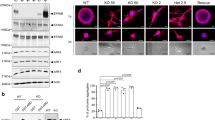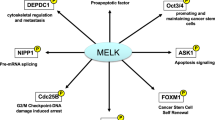Abstract
The Akt pathway is commonly deregulated in many cancers. Clinical trials are currently underway to test the effectiveness of breast cancer treatment by inhibition of various Akt pathway intermediates. A set of genes induced by Akt in a transgenic mouse model, a subset of which were sensitive to mammalian target of rapamycin (mTOR) inhibitor RAD001, was examined in five public gene expression profile data sets of clinical breast tumor specimens (representing >1000 different samples in all). In each of the clinical data sets, the Akt mouse model genes as a group were significantly overexpressed in human tumors having high levels of AKT1 mRNA. The subset of genes both upregulated by Akt and dependent on mTOR activity were associated with estrogen receptor-negative status, higher grade, increasing tumor size and poor prognosis in multiple patient cohorts; these associations were either not present or not as strong for the Akt-induced, mTOR-independent genes or for AKT1 expression alone. The genes shown here to be relevant to Akt-mTOR both experimentally and pathologically have the potential for use in a molecular diagnostic to determine which patients should receive mTOR antagonist treatment.
This is a preview of subscription content, access via your institution
Access options
Subscribe to this journal
Receive 50 print issues and online access
$259.00 per year
only $5.18 per issue
Buy this article
- Purchase on Springer Link
- Instant access to full article PDF
Prices may be subject to local taxes which are calculated during checkout



Similar content being viewed by others
Accession codes
Abbreviations
- ER:
-
estrogen receptor alpha
- PR:
-
progesterone receptor
- mTOR:
-
mammalian target of rapamycin
References
Bild AH, Yao G, Chang JT, Wang Q, Potti A, Chasse D et al. (2006). Oncogenic pathway signatures in human cancers as a guide to targeted therapies. Nature 439: 353–357.
Bose S, Chandran S, Mirocha JM, Bose N . (2006). The Akt pathway in human breast cancer: a tissue-array-based analysis. Mod Pathol 19: 238–245.
Creighton CJ, Cordero KE, Larios JM, Miller RS, Johnson MD, Chinnaiyan AM et al. (2006a). Genes regulated by estrogen in breast tumor cells in vitro are similarly regulated in vivo in tumor xenografts and human breast tumors. Genome Biol 7: R28.
Creighton CJ, Hilger AM, Murthy S, Rae JM, Chinnaiyan AM, El-Ashry D . (2006b). Activation of mitogen-activated protein kinase in estrogen receptor alpha-positive breast cancer cells in vitro induces an in vivo molecular phenotype of estrogen receptor alpha-negative human breast tumors. Cancer Res 66: 3903–3911.
Eisen MB, Spellman PT, Brown PO, Botstein D . (1998). Cluster analysis and display of genome-wide expression patterns. Proc Natl Acad Sci USA 95: 14863–14868.
Johnston SR . (2006). Clinical efforts to combine endocrine agents with targeted therapies against epidermal growth factor receptor/human epidermal growth factor receptor 2 and mammalian target of rapamycin in breast cancer. Clin Cancer Res 12: 1061s–1068s.
Kirkegaard T, Witton CJ, McGlynn LM, Tovey SM, Dunne B, Lyon A et al. (2005). AKT activation predicts outcome in breast cancer patients treated with tamoxifen. J Pathol 207: 139–146.
Lamb J, Ramaswamy S, Ford HL, Contreras B, Martinez RV, Kittrell FS et al. (2003). A mechanism of cyclin D1 action encoded in the patterns of gene expression in human cancer. Cell 114: 323–334.
Lehmann U, Kreipe H . (2001). Real-time PCR analysis of DNA and RNA extracted from formalin-fixed and paraffin-embedded biopsies. Methods 25: 409–418.
Ma XJ, Hilsenbeck SG, Wang W, Ding L, Sgroi DC, Bender RA et al. (2006). The HOXB13:IL17BR expression index is a prognostic factor in early-stage breast cancer. J Clin Oncol 24: 4611–4619.
Ma XJ, Wang Z, Ryan PD, Isakoff SJ, Barmettler A, Fuller A et al. (2004). A two-gene expression ratio predicts clinical outcome in breast cancer patients treated with tamoxifen. Cancer Cell 5: 607–616.
Majumder PK, Febbo PG, Bikoff R, Berger R, Xue Q, McMahon LM et al. (2004). mTOR inhibition reverses Akt-dependent prostate intraepithelial neoplasia through regulation of apoptotic and HIF-1-dependent pathways. Nat Med 10: 594–601.
Miller LD, Smeds J, George J, Vega VB, Vergara L, Ploner A et al. (2005). An expression signature for p53 status in human breast cancer predicts mutation status, transcriptional effects, and patient survival. Proc Natl Acad Sci USA 102: 13550–13555.
Morgensztern D, McLeod HL . (2005). PI3K/Akt/mTOR pathway as a target for cancer therapy. Anticancer Drugs 16: 797–803.
Paik S, Shak S, Tang G, Kim C, Baker J, Cronin M et al. (2004). A multigene assay to predict recurrence of tamoxifen-treated, node-negative breast cancer. N Engl J Med 351: 2817–2826.
Saldanha AJ . (2004). Java Treeview – extensible visualization of microarray data. Bioinformatics 20: 3246–3248.
Shaw RJ, Cantley LC . (2006). Ras, PI(3)K and mTOR signalling controls tumour cell growth. Nature 441: 424–430.
Sorlie T, Tibshirani R, Parker J, Hastie T, Marron JS, Nobel A et al. (2003). Repeated observation of breast tumor subtypes in independent gene expression data sets. Proc Natl Acad Sci USA 100: 8418–8423.
Sweet-Cordero A, Mukherjee S, Subramanian A, You H, Roix JJ, Ladd-Acosta C et al. (2005). An oncogenic KRAS2 expression signature identified by cross-species gene-expression analysis. Nat Genet 37: 48–55.
Tian L, Greenberg SA, Kong SW, Altschuler J, Kohane IS, Park PJ . (2005). Discovering statistically significant pathways in expression profiling studies. Proc Natl Acad Sci USA 102: 13544–13549.
Tokunaga E, Kimura Y, Oki E, Ueda N, Futatsugi M, Mashino K et al. (2006). Akt is frequently activated in HER2/neu-positive breast cancers and associated with poor prognosis among hormone-treated patients. Int J Cancer 118: 284–289.
van de Vijver MJ, He YD, van't Veer LJ, Dai H, Hart AA, Voskuil DW et al. (2002). A gene-expression signature as a predictor of survival in breast cancer. N Engl J Med 347: 1999–2009.
Wang Y, Klijn JG, Zhang Y, Sieuwerts AM, Look MP, Yang F et al. (2005). Gene-expression profiles to predict distant metastasis of lymph-node-negative primary breast cancer. Lancet 365: 671–679.
Author information
Authors and Affiliations
Corresponding author
Rights and permissions
About this article
Cite this article
Creighton, C. A gene transcription signature of the Akt/mTOR pathway in clinical breast tumors. Oncogene 26, 4648–4655 (2007). https://doi.org/10.1038/sj.onc.1210245
Received:
Accepted:
Published:
Issue Date:
DOI: https://doi.org/10.1038/sj.onc.1210245
Keywords
This article is cited by
-
ISGylation drives basal breast tumour progression by promoting EGFR recycling and Akt signalling
Oncogene (2021)
-
Combination inhibition of PI3K and mTORC1 yields durable remissions in mice bearing orthotopic patient-derived xenografts of HER2-positive breast cancer brain metastases
Nature Medicine (2016)
-
Ambivalent role of pFAK-Y397 in serous ovarian cancer-a study of the OVCAD consortium
Molecular Cancer (2014)
-
The interaction between ER and NFκB in resistance to endocrine therapy
Breast Cancer Research (2012)
-
Pleiotropic effects of miR-183~96~182 converge to regulate cell survival, proliferation and migration in medulloblastoma
Acta Neuropathologica (2012)



